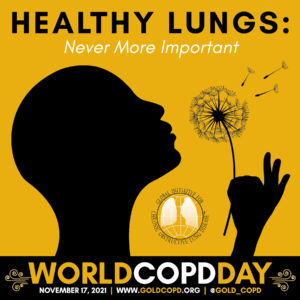COPD Awareness
Posted on by November is National COPD Awareness Month and November 17, 2021 is World COPD Day. This year’s theme, “Healthy Lungs – Never More Important,” highlights that even during the COVID pandemic, COPD remains a leading cause of death worldwide and it remains important to focus on lung health.
November is National COPD Awareness Month and November 17, 2021 is World COPD Day. This year’s theme, “Healthy Lungs – Never More Important,” highlights that even during the COVID pandemic, COPD remains a leading cause of death worldwide and it remains important to focus on lung health.
COPD, or chronic obstructive pulmonary disease, is a progressive nonreversible disease that makes it hard to breathe. COPD includes chronic bronchitis and emphysema. COPD is the fourth leading cause of death in the U.S. Cigarette smoking is the leading cause of COPD and most people who have COPD smoke or used to smoke. Workplace exposures are also important contributors to the burden of COPD. Long-term exposure to lung irritants—such as air pollution, chemical fumes, or dusts—also may contribute to COPD.
A recent study, Chronic Obstructive Pulmonary Disease and U.S. Workers: Prevalence, Trends, and Attributable Cases Associated with Work, examined COPD prevalence, trends and the proportion of cases attributable to work, during 2012–2018 among workers looking at smoking status, industry, and occupation. The study revealed that there had been an increase in COPD prevalence since 2012. During the period from 2012–2018, overall
- an estimated 5.8 million U.S. workers had COPD,
- 40% (2.3 million) of COPD cases were among those who never smoked, and
- 27% of COPD cases were attributable to the industry where they worked.
From 2012 to 2018, an overall increase in the estimated annual average COPD prevalence was observed among all U.S. workers and workers in certain industry and occupations. Workers in the merchant wholesale non–durable industry (i.e., paper, grocery, chemical, farm product and petroleum wholesalers), and the arts entertainment, and recreation industry had significant increases in COPD prevalence. Similarly, workers in certain occupations had a significant increase in COPD prevalence from 2012 to 2018 including:
- financial specialists;
- supervisors, other food services workers;
- supervisors, building grounds and maintenance workers;
- personal care and services workers;
- supervisors, office and administrative support workers; and
- motor vehicle operators and material moving workers.
Although the exact cause of the increasing COPD trends is unknown, some of these increases could be explained, in part, by higher tobacco smoking prevalence, environmental exposures, and workplace exposures among these workers.
The food services and drinking places industry had the highest percent of COPD cases attributable to industry and motor vehicle operators and material moving occupations had the highest percent of cases attributable to occupation. Workers in these groups are exposed to certain chemicals; dusts; fumes; and vapors, including silica, fiberglass, sawdust, solvents, secondhand smoke, and welding fumes. These exposures have been previously associated with COPD.
Of the 2.3 million workers with COPD who never smoked, an estimated 24% of COPD cases were attributable to work and these proportions varied by industry and occupation. Workers in the education industry and administrative support occupations had the highest percent of COPD cases attributable to industry and occupation, respectively. Previous findings show that workers in these industry and occupation groups are exposed to environmental tobacco smoke; vapors; fumes; and other known respiratory irritants, including exposure to paper dust and fumes from photocopiers, chemicals, oil-based ink, paints, and glues, all of which have been associated with bronchitis, emphysema, and COPD.
These findings add to the evidence that workplace exposures are associated with an increased burden of COPD. Targeted intervention strategies addressing both tobacco smoking and workplace exposures are needed to reduce the burden of COPD among workers, especially among groups with higher prevalence.
Girija Syamlal, MBBS, MPH, is a research epidemiologist in the NIOSH Respiratory Health Division.
Posted on by

